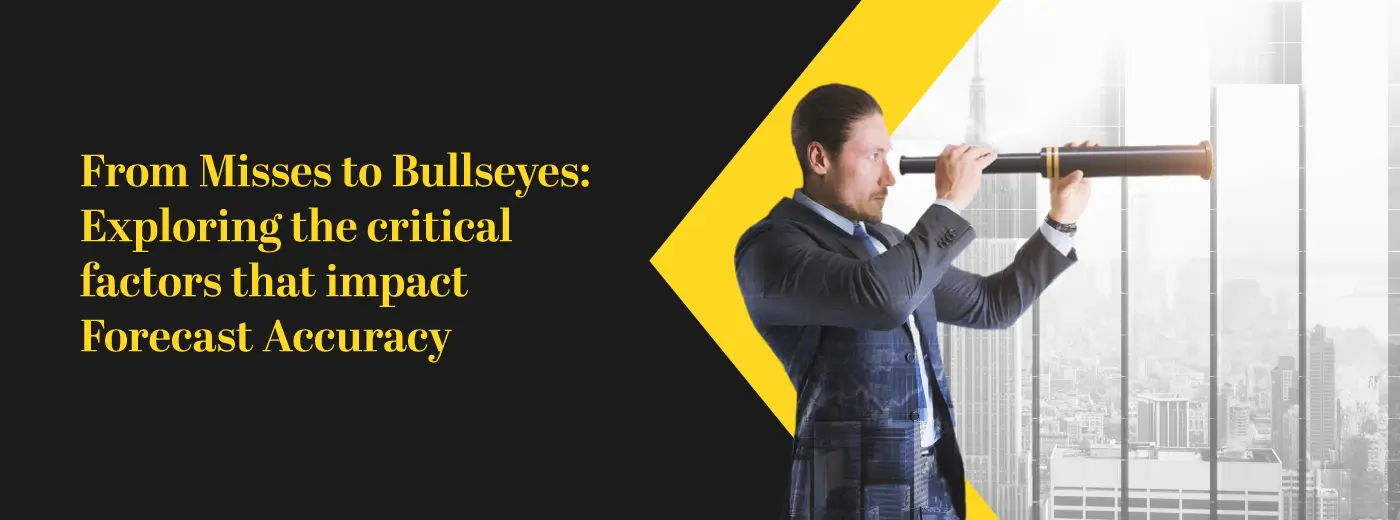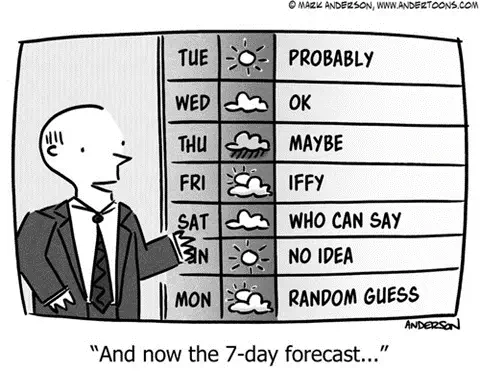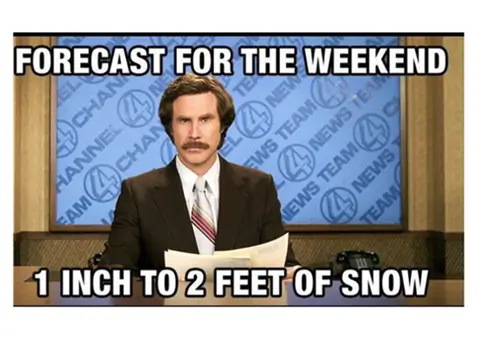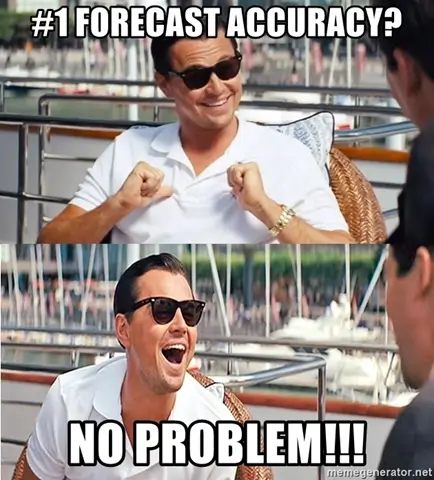
Sign up to receive latest insights & updates in technology, AI & data analytics, data science, & innovations from Polestar Analytics.
Editor's Note: Predicting the future is no longer a mysterious art but a data-driven science. Our latest blog unravels the secrets behind improving forecast accuracy and reveals essential tips for making precise predictions. Don't miss this interesting read to enhance your decision-making process and stay one step ahead of the competition.
When it comes to running an organization, there's a common refrain among business leaders: "We need to improve our forecasting!" And it's no wonder why. Accurate forecasting can be a game-changer for enterprises, enabling them to seize opportunities, navigate uncertainty, and stay ahead of the competition.

However, achieving consistent and highly accurate forecasts is a formidable challenge that many organizations struggle with. Unforeseen events, such as the sudden impact of COVID-19, have proven the limitations of traditional forecasting techniques. Predicting the timing and severity of a recession, for instance, is a difficult task.
But imagine if you could peer into the future of your business. Imagine having the power to make decisions based on accurate predictions of market conditions and future trends. With accurate forecasting, this is not just a daydream—it's a reality.
By harnessing the ocean of historical and current data at your disposal, you can unlock insights that drive accurate predictions. This newfound visibility empowers you to analyze your business with unwavering confidence in the data, enabling organizations to make informed decisions that lead to success.
In this captivating blog, we delve into the paramount importance of accurate forecasting. We explore the key metrics that gauge forecasting accuracy and reveal how it can revolutionize your business, bringing both enhanced precision and simplicity to your business operations.
Demand prioritization: Categorizing products based on their forecast accuracy helps prioritize which ones require a thorough review. Planners have limited capacity and can only review a select number of products, so it is crucial to identify consistently inaccurate products for their review. Products that consistently have accurate forecasts can be managed in an automated manner, eliminating the need for manual review by planners. This improves the efficiency and productivity of planners.
Demand shaping: Close examination of consistently inaccurate products enables the identification of underlying causes. These causes may be internal, such as the promotion of related products, or external, such as competition, pandemics, or natural disasters. Once the causes are identified, appropriate mitigation actions can be taken to improve forecast accuracy.
Safety stock: Understanding the potential deviation between actual demand and forecasted demand is crucial for developing contingency plans. Forecast error plays a significant role in determining the required level of safety stock. Higher forecast errors necessitate larger safety stock levels to maintain a given service level.

Peering into the future has always captivated the human imagination, but in the realm of business and decision-making, accurate forecasting takes center stage. From boardrooms to stock markets, the ability to predict future outcomes with precision can be the key to success or failure. Below are five key factors that play a crucial role in determining how accurate a forecast will be:
1. Data Quality and Quantity
The quality and quantity of data used for forecasting have a substantial impact on accuracy. If the data is incomplete, outdated, or contains errors, it can lead to misleading predictions. Similarly, insufficient data might result in oversimplified models that fail to capture the complexities of the underlying patterns. Therefore, it's crucial to have clean, relevant, and sufficient data to build accurate forecasting models.
2. Forecasting Models
The choice of forecasting method or technique can significantly affect accuracy. Different methods, such as time series methods (e.g., ARIMA, Exponential Smoothing) and causal methods (e.g., regression analysis), may perform better under specific circumstances. The appropriateness of the chosen method depends on the underlying patterns and characteristics of the data. The best approach is to compare the performance of various methods on historical data before selecting the most suitable one.
3. Seasonality and Trends
Many time series data exhibit seasonality (regular patterns that repeat over fixed intervals) and trends (long-term upward or downward movements). Accurate forecasting requires models that can identify and account for these patterns appropriately. Failing to address seasonality and trends can lead to biased predictions. Methods like seasonal decomposition and trend analysis are commonly employed to handle these aspects.
4. External Factors and Events
Forecasting accuracy can be affected by unexpected external factors and events, such as natural disasters, economic downturns, policy changes, or pandemics. These factors are often difficult to predict and not present in historical data. Incorporating external variables or using scenario-based forecasting approaches can help account for such uncertainties, although they cannot guarantee complete accuracy in the face of extreme events. So, it's essential to consider these factors and their potential effects on the forecasted outcomes.
5. Forecast Aggregation
This involves combining forecasts from multiple sources or business units to improve the overall accuracy of predictions. The idea behind forecast aggregation is that individual forecasts may contain biases, errors, or limited perspectives, but by combining them, collective wisdom can lead to more accurate and reliable forecasts. This concept is commonly used in various fields, such as finance, supply chain management, and macroeconomic forecasting.
Remember that forecasting accuracy is not solely dependent on a single factor, but rather, it is influenced by the interaction of multiple factors. To achieve the best results, continuous monitoring and refining the forecasting process based on feedback and real-world performance will lead to increasingly accurate predictions.
Embrace uncertainty with confidence by mastering the art of accurate forecasting.

There are multiple algorithmic calculations and formulas that serve as the compass guiding you toward the accuracy of your forecasts. They’re utilized for businesses that depend on market predictions or economic forecasts, also for any other kind of organizational needs to predict future outcomes.
| Metric | Formula | Applications | Use Cases |
|---|---|---|---|
| Mean Absolute Error (MAE) | (1/n) * Σ | Measures the average magnitude of errors | Provides a simple and interpretable measure of forecast accuracy |
| Mean Squared Error (MSE) | (1/n) * Σ | Measures the average squared difference between actual and forecasted values | Amplifies larger errors compared to MAE, penalizing outliers and more |
| Root Mean Squared Error (RMSE) | √((1/n) * Σ | Measures the average percentage difference between actual and forecasted values | Provides a relative measure of forecast accuracy, taking into account the magnitude of the actual values |
| Mean Absolute Percentage Error (MAPE) | √((1/n) * Σ | Measures the square root of the MSE, providing the standard deviation of errors | Enables comparison with the original scale of the data and provides a more interpretable measure of error |
| Symmetric Mean Absolute Percentage Error (SMAPE) | (1/n) * Σ | Measures the average percentage difference, considering the average of actual and forecasted values | Provides a symmetric measure of percentage deviation that is insensitive to zero values |
| Mean Percentage Error (MPE) | (1/n) * Σ | Measures the average percentage difference between actual and forecasted values, without considering direction | Provides a measure of the forecast bias, indicating whether the forecast tends to be too high or too low on average |
| Forecast Bias | (1/n) * Σ | Measures the average deviation of forecasts from actual values, without considering direction | Indicates the overall tendency of the forecast to be too high or too low, without distinguishing between over- and under-forecasting. |
It's an important part of the forecasting process. By regularly tracking forecast accuracy, you can identify areas where the forecast is inaccurate and make changes to improve accuracy. This will help you make better decisions about inventory, production, and other aspects of your business operations.

Remember that forecasting accuracy may vary depending on the nature of the data and the specific business problem you are trying to solve. Monitoring forecast accuracy allows you to continuously improve your forecasting models and make more informed decisions based on reliable predictions.
Henceforth, accurate forecasting is the compass that guides organizations to success. Factors like data quality, models, seasonality, external factors, and aggregation influence accuracy. Continuously monitoring by tracking forecast accuracy, analyzing errors, and identifying root causes of inaccuracies, organizations can continuously improve their forecasting models and make well-informed decisions based on reliable predictions.
So, as businesses strive for progress and improved performance, seeking assistance from experienced partners like Polestar Analytics can pave the way for a brighter, more successful future. Talk to us today!
About Author

Content Architect
The goal is to turn data into information, and information into insights.